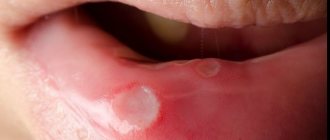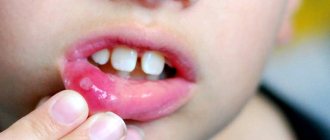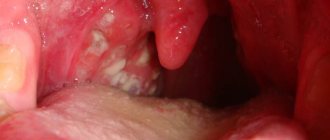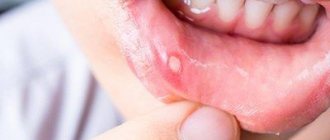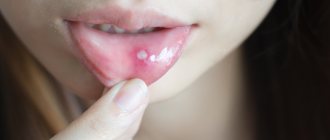Despite the fact that this disease is considered typically childhood, candidal stomatitis can often be found in adults, especially in old age. It is a fungal infection of the soft tissues of the oral cavity, which causes inflammation. The disease is caused by fungi of the genus Candida albicans, and due to the characteristic whitish coating on the mucous membranes, it is often called simply thrush.
ETIOLOGY OF CANDIDOSAL STOMATITIS
The etiology of canida stomatitis, as you could understand above, is simple. That is, the cause of candidal stomatitis is yeast-like fungi of the genus Candida. Let's get to know them. These fungi are classified as imperfect fungi, DEUTEROMYCETES, which have a complex structure. Firstly, they have a cell wall, which consists of 5-6 layers, secondly, they have a perforating organ that affects the host cells, and thirdly, they have significant differences in comparison with other yeast-like fungi.
The difference between fungi of the genus Candida and other yeast-like fungi is as follows:
- Ability to grow in an environment with a temperature of 30 -37 degrees Celsius;
- The optimal environment is slightly acidic/acidic (pH = 5.8 – 6.5)$
- Ability to ferment carbohydrates (main source of nutrition);
- Aerobes (love oxygen);
- Choose media with glycogen.
In general, candida is a conditionally pathogenic fungus, which means that in the absence of factors, they are basically safe. But as soon as changes occur in this balance, they become pathogenic. That is, you need to know and understand exactly what conditions lead to the activation of the pathogenicity of fungi of the genus Candida. After all, the main role here is played not by pathogenicity factors, but by the state of the immune defense of the human body. Of course, the pathogenicity of Candida fungi for animals and humans is different. For humans, the most dangerous is Candida albicans, for children - Candida tropicalis.
PREDISPOSIBLE FACTORS TO CANDIDOSAL STOMATITIS
Factors that contribute to the activation of pathogenic factors by candida are the following:
- A decrease in the body’s defenses - immunity (and who else remembers anything, let me clarify: namely cellular immunity);
- The presence of congenital or acquired immunodeficiencies;
- Metabolic disorders, endocrine disorders (for example, diabetes mellitus, amenorrhea, iron deficiency, etc.)
- Vitamin deficiencies (especially vitamins B1, B2, B12, which are involved in suppressing the action of microorganisms)
- Acute infectious diseases, or exacerbations of chronic diseases;
- Diseases of the female genital organs;
- Long-term use of oral contraceptives;
- Pregnancy;
- Large burns;
- Rickets;
- Prematurity;
- Oncology;
- Diseases of the gastrointestinal tract;
- Taking antibiotics, large doses of drugs, immunosuppressants;
- Working conditions. It was noticed that people working in hydrolysis-yeast factories, in factories for the production of antibiotics, beer and other alcoholic beverages, more often than others suffer from candidal stomatitis;
- Failure to comply with personal hygiene rules;
- Failure to maintain cleanliness and order in household items (candida can be found on children's toys, plates, cups, etc.);
- Eating unwashed vegetables and fruits;
- In infants, candidal stomatitis most often forms when they are overheated, that is, when wearing tight pajamas, bulky swaddling, etc.
- Artificial feeding of children up to 6 months;
- Iatrogenic factors: acute damage to fillings, incorrectly fitted dentures, chemical burns from formaldehyde, arsenic pastes, etc. That is, everything that leads to disruption of the integrity of the oral mucosa.
As you can see, there are a lot of reasons and facts for the activation of Candida. Therefore, the approach to treatment must be adequate, and the CAUSE must be treated first, and only then the manifestations.
PATHOGENESIS OF CANDIDOSAL STOMATITIS
The pathogenesis of candidal stomatitis is quite simple: the fungus is located on the surface of the oral mucosa or on the surface of the skin, and in the absence of damage or provoking factors, it does not penetrate the epithelium; if present, it is clear that it penetrates and visible pathology begins.
However, these are only two of the FIVE mechanisms of action of mushrooms on the body. Candidiasis is a very serious problem, because it can spread to organs. Thus, after penetration into the epithelium, Candida is able to interact with macrophages and neutrophils. After which it penetrates into the cells of organs such as the liver, heart, kidneys - granulomas are formed. And the very last and ominous stage is penetration into the blood and the development of candidemia. After which death occurs.
Therefore, in order to prevent this, read on and remember J
CLASSIFICATION OF CANDIDOSAL STOMATITIS
- Classification of candidal stomatitis according to ICD-10:
- AOO-B99 Some infectious and parasitic diseases;
- B35-B49 Mycoses;
- B37 Candidiasis
- B37.0 Candidal stomatitis - oral thrush.
- Classification of candidal stomatitis N.D. Sheklakov:
- Superficial candidiasis of mucous membranes, skin, nails;
- Chronic generalized (granulomatous) candidiasis;
- Visceral (systemic) candidiasis.
- With the flow:
- Acute pseudomembranous candidiasis (thrush);
- Acute atrophic candidiasis;
- Chronic hyperplastic candidiasis;
- Chronic atrophic candidiasis.
SYMPTOMS OF CANDIDOSAL STOMATITIS
In the future, we will look at the symptoms of candidal stomatitis, even each form separately. Here I will only indicate common symptoms with which a patient may seek help.
Symptoms of candidal stomatitis:
- Pain when eating;
- Pain at rest;
- Burning;
- Itching;
- Dry mouth;
- Bad breath;
- Presence of spots on the mucous membrane;
- Perversion (change) of taste;
- Bleeding gums;
- Enlarged lymph nodes;
- Increased body temperature;
Most often, wounds are located on the mucous membrane of the cheeks, palatine tonsils and lips on the inside. Less often on the tongue and under the tongue.
Differences between stomatitis and thrush
The oral mucosa reacts sharply to fluctuations in acidity levels, mechanical and physical influences, bacterial or viral infections. In the case of thrush, a white coating can be found in the child’s mouth - it is caused by a fungus from the genus Candida.
Thrush is also called candidal stomatitis . But other factors may also cause inflammation of the mucous membrane and the development of stomatitis. For example, these could be bacteria (most often staphylococci or streptococci), viruses (usually herpes), mechanical injuries or strong allergens.
Candidiasis in a child
Before starting self-treatment, you should definitely consult a pediatrician or pediatric dentist to identify the cause of the inflammation and receive the correct therapy. Concomitant diseases that suppress the immune system can also intensify the inflammatory process.
Factors that provoke the development of different types of stomatitis and thrush:
- development of pathogenic microflora in the oral cavity;
- unwashed fruits and vegetables;
- weak local immunity;
- taking antibiotics by both the child and the mother;
- damage to the mucous membrane, due to the fact that the baby puts everything he sees into his mouth;
- teething;
- dry mucous membrane;
- lack of hygiene;
In healthy children with strong immunity, thrush or candidal stomatitis with mild symptoms may disappear on their own, without treatment. And in weak and sickly babies, a white coating can be found throughout the mucous membrane, on the tongue, gums, and pharynx. This creates difficulties when sucking and swallowing, and appetite is disrupted.
Such babies may not latch onto the breast, be capricious, and cry. Many doctors say that one of the main reasons causing stomatitis or thrush in children is an imperfect immune system and, accordingly, weak antiseptic properties of saliva in children.
The mucous membrane in the oral cavity is thin and sensitive, and it is quite easy to injure it, but then it is much more difficult to restore it.
It is necessary to determine the type of infection and the accompanying factors that provoked it in order to quickly select the correct treatment and improve the patient’s well-being. Thrush most often affects children from birth to 3 years of age.
Allergic stomatitis affects primary school students with weakened immune systems. Bacterial stomatitis can occur in children of any age, and viral stomatitis often affects children from birth to 3 years of age.
Stomatitis in a child
This disease is accompanied by painful sensations throughout the mucous membrane, burning, dryness, decreased appetite, anxiety and irritability. The entire mucous membrane is swollen, red, blisters, erosions and ulcers may occur.
It is necessary to start treatment in a timely manner so as not to aggravate the situation and prevent the appearance of small plaques with a white border (aphtha). The child constantly cries, does not eat and loses weight, and a high temperature may rise.
DIAGNOSIS OF CANDIDOSAL STOMATITIS
Diagnosis of candidal stomatitis will be based on the patient’s data and clinical examination by a specialist. In addition, to confirm the diagnosis of CANDIDOSAL stomatitis, it is necessary to conduct laboratory diagnostics. To do this, I make a scraping (smear) from the surface and send it to the laboratory. In the laboratory, materials are studied in 2 directions:
- Sowing on nutrient media - Sabouraud's medium, wort - agar or candida - agar;
- Microscopy of stained smears.
Isolation of 300 colonies in 1 ml indicates candidiasis. Detection of a larger number of colonies during initial culture indicates candidiasis. But the diagnosis will be confirmed only with repeated culture and when the numbers are higher than 300 colonies per 1 ml.
ACUTE PSEUDOMEMBRANOSUS CANDIDIASIS
Acute pseudomembranous candidiasis is the most common form of candidiasis of the oral mucosa. It is acute pseudomembranous candidiasis that is thrush, and not any other types of candidiasis. What I mean is that not every stomatitis or candidiasis is silent. Infants and weakened adults are more often affected.
Symptoms of acute pseudomembraous canidosis:
- Complaints about the child refusing to feed;
- Children are lethargic and capricious;
- Complaints of pain when eating, burning and dry mouth.
Clinic of acute pseudomembraous canidosis:
On the mucous membrane of the oral cavity there are white or blue-white spots - a coating similar to “curdled masses”. Which in some cases are easily scraped off and the hyperemic surface is exposed. In other cases, the plaque is difficult to scrape off, bleeds, and an eroded surface is revealed. The process most often affects the tongue, palate, lips, but can spread to the pharynx, larynx and esophagus. If there is no treatment, acute pseudomembranous candidiasis turns into acute atrophic candidiasis.
ACUTE ATROPHIC CANDIDIASIS
Symptoms of acute atrophic candidiasis:
- Complaints of dryness and burning in the mouth;
- Pain when chewing, when talking;
- Inability to open your mouth wider;
- Complaints about scales on the lips;
- For dry and cracked lips.
Clinic of acute atrophic candidiasis:
The clinic of acute candidal stomatitis differs from the clinic of acute pseudomembranous canidosis in the ABSENCE of plaque.
In acute atrophic candidiasis, the mucous membrane is hyperemic, it is very red, it is called fiery, and it is also dry, which makes it difficult to open the mouth. There is no raid. On the tongue there is atrophy of the papillae (that is, smoothness of the pattern), the tongue is smooth and bright red. There may be teeth marks on the tongue. The red border of the lips is hyperemic, dry, with the presence of gray scales. There are cracks and erosions in the corners of the lips.
CHRONIC HYPERPASTIC CANDIDIASIS
Symptoms of chronic hyperplastic candidiasis:
- Complaints of pain when eating spicy, hot food;
- Perversion (change) of taste;
- Burning in the mouth.
Clinic of chronic hyperplastic candidiasis:
The appearance of plaques (“cobblestones”) is noted on the hyperemic mucosa. Plaques are gray-white, tightly adhered to the mucous membrane, which, when removed, contributes to bleeding and pain. Most often they are located on the back of the tongue. May spread to the tonsils, pharynx, throat and esophagus.
CHRONIC ATROPHIC CANDIDIASIS
Most often, chronic atrophic candidiasis is diagnosed in patients with oral dentures.
Symptoms of chronic atrophic candidiasis:
- Complaints of burning;
- Complaints of pain when eating;
- Complaints of dry mouth
Clinic of chronic atrophic candidiasis:
The mucous membrane under the prosthetic bed is swollen and hyperemic. In some places there is an easily removable white coating. When removing white plaque, the surface becomes hyperemic. In the corners of the mouth there are erosions, also covered with a white coating. There may be damage to the tongue: the tongue is smooth, the papillae are atrophied, teeth marks are on the tongue. In some cases, hypertrophy of the filiform papillae is noted - “black hairy tongue”
Candidiasis (thrush)
Candida
enter the oral cavity . In children, thrush is often confused with stomatitis. It is most often transmitted from poorly washed, unsterile nipples, bottles, as well as from an infected mother, through the birth canal, with low immunity. Most children get sick before they are one year old. Parents complain about a white, curd-like coating.
Treatment
Infants are not prescribed serious medications for uncomplicated cases. The dentist recommends cleaning this plaque with a soda solution (1 teaspoon per glass of warm water). An ear stick, as an option. The same solution is used to treat nipples, bottles, toys, and mother's nipples during breastfeeding. In most cases, candidiasis quickly passes without leaving a trace. Prevention includes regular monitoring of the sterility of items used by the child.
TREATMENT OF CANDIDOSAL STOMATITIS
Treatment of candidal stomatitis should be strictly individual. After all, most often, as I said earlier, candidal stomatitis is a secondary disease, so it is necessary first of all to look for the cause and eliminate it.
Treatment of candidal stomatitis should be both general and local.
General treatment for candidal stomatitis is:
- Prescribing general restorative therapy;
- Prescribing antifungal drugs;
- Prescribing diets excluding sweets and other carbohydrates. Food should be rich in fiber.
Preference is given to polyene antibiotics as the main remedy for the treatment of candidal stomatitis. Examples of drugs would be nystatin, levorin (it is advisable to dissolve the tablet and throw it away, since polyene antibiotics are poorly absorbed by the body). In parallel, multivitamin complexes with B vitamins, calcium and iron are prescribed. Desensitizing therapy is also carried out with drugs such as diphenhydramine and suprastin.
Local treatment of candidal stomatitis consists of:
- In the application of polyene antibiotics to the mucosa in the form of solutions or ointments for 14 days, 3-4 times a day;
- In the appointment of alkaline applications with 2-4% sodium bicarbonate solution.
- A thorough sanitation of the oral cavity, professional hygiene, and replacement of old and irrational orthopedic structures are carried out.
Treatment of thrush
Stomatitis or thrush in infants can cause a rapid increase in temperature and inflammation of the lymph nodes. Foci of thrush localization occur on the lips, cheeks, and tongue, but can also cover the pharynx.
The mucous membrane becomes covered with a cheesy, white coating. In the initial stages of the disease, it can be easily removed with a bandage soaked in a soda solution. All the mucous membrane underneath will be red and inflamed.
In case of mild illness, the temperature may not rise or be low-grade. A child who is bothered by thrush eats poorly and experiences pain.
Itching, dryness, burning, inflammation cause a lot of discomfort and trouble for the baby. Parents have a question: when can a child feel relief?
With normal care, following all doctor's recommendations and treating the oral cavity with soda solution, symptoms may disappear after 3-6 days.
In breastfed children, after each feeding, the mucous membrane in the mouth and the mother's peripapillary area should be treated with a soda solution.
Gel "Myconaz"
If necessary, your doctor may prescribe antifungal medications. Candide lotion and Miconaz gel have proven effectiveness; they are approved for use from birth.
A fungal infection lowers the pH level , and an acidic environment only promotes the development of fungi. To neutralize the acid and restore the alkaline environment, treatment with a 2% baking soda solution is necessary.
PREVENTION OF CANDIDOSAL STOMATITIS
Prevention of candidal stomatitis includes:
- Competent prescription and use of antibiotics, antidepressants, etc.;
- Timely treatment of diseases;
- Pregnancy planning;
- Thorough cleaning of rooms;
- Whitening only washed vegetables and fruits, fresh meat and dairy products;
- Visit the dentist at least once every six months;
- Mothers should provide their baby with clean nipples and bottles and not neglect hygiene.
Thanks for reading! Take care of yourself and your loved ones!


